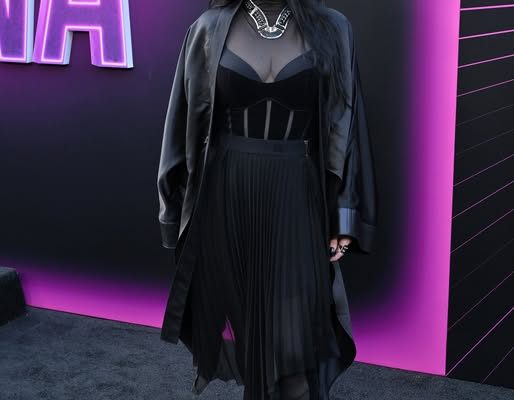For over two decades, Amy Lee has stood as an almost unshakable figure in the world of goth rock, a voice and presence that has defined an entire generation’s idea of darkness, elegance, and musical catharsis. As the frontwoman of Evanescence, she became a cultural phenomenon in the early 2000s, shaping what mainstream audiences thought goth rock sounded like, looked like, and felt like. But as time has moved forward, and new generations of artists have stepped into the scene with their own variations of dark aesthetics and moody soundscapes, the question inevitably arises: does Amy Lee still sit unchallenged as the Queen of Goth Rock, or has a new wave of musicians quietly taken the throne she once ruled with such authority?
To answer this, one must first acknowledge what Amy Lee accomplished at her peak. The release of Fallen in 2003 was not just a successful debut—it was a seismic event. The album sold millions, propelled by tracks like “Bring Me to Life” and “My Immortal,” songs that merged heavy guitar riffs, haunting piano, and Lee’s classically trained voice into something that felt both crushingly powerful and heartbreakingly fragile. Her image, often draped in black lace, corsets, and long gothic gowns, crystallized the archetype of a modern goth rock frontwoman for mainstream audiences. She wasn’t simply singing about pain, loss, and yearning; she embodied it. For a generation of teenagers growing up in the early 2000s, Amy Lee was not just a musician—they saw in her a symbol of self-expression, an invitation to embrace darkness without shame, and a reminder that vulnerability could be a form of strength.
But music is not static, and neither is culture. The very genre that Amy Lee helped popularize—if not redefine—has seen shifts over the past twenty years. Goth rock itself, originally springing from post-punk and bands like Bauhaus, Siouxsie and the Banshees, and The Sisters of Mercy, has fragmented into countless subgenres and fusions: gothic metal, darkwave, ethereal wave, industrial goth, and even gothic pop. Amy Lee’s Evanescence carved out a commercially viable bridge between gothic aesthetics and alternative metal, but since then, a younger wave of artists has taken inspiration from her blueprint and warped it into their own creations. Bands like Within Temptation, Nightwish, and Lacuna Coil explored similar terrain, while solo artists like Chelsea Wolfe and Zola Jesus pushed goth-inspired music into more experimental and atmospheric realms. Even outside the strict confines of “goth rock,” one can find Amy Lee’s influence lingering in the theatricality of Billie Eilish’s early visuals, the emotional vulnerability of Halsey’s darker material, and the symphonic grandeur of modern metal acts with female vocalists.
Yet despite these shifts, Amy Lee herself has never truly disappeared from the conversation. Evanescence has continued releasing music, with albums like The Open Door, Evanescence, and The Bitter Truth proving that she was not content to live off past glories. Each release has carried her unmistakable voice, still rich with operatic force and emotional depth, reminding fans why she earned the crown in the first place. In live performances, too, she has demonstrated a staying power that few from her era can match. Her concerts still attract crowds of dedicated fans, many of whom discovered her two decades ago but remain loyal, while newer generations—often introduced through streaming services or TikTok rediscoveries—come to witness the same magnetic presence. Unlike some artists who retreat into nostalgia tours, Amy Lee has maintained a sense of relevance, even as trends shift around her.
But to ask if she is still the Queen of Goth Rock is to also recognize that monarchy in music is never absolute. Unlike pop, where dominance can be measured by chart positions and streaming numbers, goth rock thrives in subcultures, underground venues, and communities that often reject mainstream validation altogether. In that sense, Amy Lee’s visibility might actually work against her claim to the throne, since many goth purists argue that Evanescence was always more gothic-tinged alternative metal than true goth rock. For them, her reign was never truly legitimate in the first place, more a media creation than a grassroots coronation. That critique, however, does not erase the undeniable fact that she made goth aesthetics accessible to millions who might otherwise never have encountered the genre at all. She was a gateway artist, a figure who invited outsiders into the world of darkness, where they might then discover other acts both older and newer.
Meanwhile, the landscape of goth-inspired music today has broadened in ways that complicate any single claim to a throne. Artists like Chelsea Wolfe craft music that feels far closer to the core of gothic sensibilities, with its mixture of doom-laden riffs, whispered vocals, and ritualistic atmosphere. Zola Jesus merges avant-garde electronics with brooding lyrical themes, carving out her own dark niche. Lingua Ignota has turned trauma into art that is as terrifying as it is transcendent, pushing the boundaries of what gothic music can confront. Then there are artists like Emma Ruth Rundle, who blend folk melancholy with gothic sensibilities, and acts like Drab Majesty and Boy Harsher, who keep the legacy of synth-driven darkwave alive for new audiences. Even in the mainstream, someone like Billie Eilish, while not a goth artist per se, has wielded darkness, morbidity, and haunting vulnerability in a way that recalls Amy Lee’s influence. In this context, one could argue that the throne has fragmented; there is no longer one Queen, but many rulers presiding over their respective dark dominions.
Still, if monarchy is measured by recognition, influence, and cultural imprint, Amy Lee’s claim remains formidable. She is a name known beyond goth circles, someone who has transcended the underground while still retaining credibility. For younger artists, she often functions as a north star—proof that one can embrace vulnerability and theatricality while still achieving mass success. Unlike many of her contemporaries, Amy Lee’s artistry has not been marred by scandal, nor has she dramatically reinvented herself in ways that alienated her base. Instead, she has remained consistent, maturing rather than radically shifting, refining her presence rather than chasing trends. For many fans, that reliability is precisely why she still feels like a reigning queen; in a world where musical tastes evolve at lightning speed, her continued authenticity feels like an anchor.
Another dimension of this debate is live presence. For all the discussion of studio albums and cultural relevance, much of goth rock’s identity has always been tied to performance. Amy Lee on stage remains a commanding figure: the long flowing gowns, the moody piano interludes, the moments where her voice soars above crushing guitars. It is in these performances that she continues to embody what a Queen of Goth Rock should be. Younger artists may push boundaries or innovate in new directions, but few can match the sense of grandeur and theatrical immersion that Amy Lee brings to her shows. She has lived long enough to see her music move from MTV to YouTube to TikTok, and yet her live performances remain timeless experiences, immune to the changing platforms of cultural consumption.
Ultimately, whether Amy Lee is still the Queen of Goth Rock depends less on objective measures and more on one’s definition of the genre and its throne. If one sees goth rock as a lineage rooted in the underground, she may never have truly claimed the crown to begin with. If one views it as an aesthetic and emotional sensibility brought into mainstream consciousness, she reigns as one of the most visible figures to ever embody it. What cannot be denied is that her influence continues to ripple outward. Entire generations of artists, whether consciously or unconsciously, owe something to the path she carved. Even those who surpass her in innovation or underground credibility are, in some way, building on a world she helped shape.
Perhaps the real answer is not whether she is still Queen or whether someone else has replaced her, but whether the concept of a single monarch even applies anymore. Music today thrives on decentralization; genres bleed into each other, online platforms flatten hierarchies, and audiences form communities around micro-scenes rather than universal icons. In such a landscape, Amy Lee’s continued presence feels less like a contested throne and more like an eternal pillar—a monument to a time when goth rock briefly ruled the airwaves, and a reminder that darkness never fully goes out of style. The new generation may be carrying the torch in their own ways, exploring darker, weirder, and more experimental terrains, but the original flame lit by Amy Lee still burns brightly, illuminating the path for those who follow.



